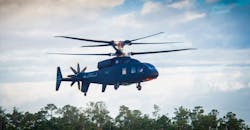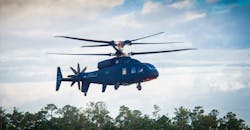Helicopters are very much a part of most battleplans, although these aircraft are sometimes limited in speed and agility. As a replacement for conventional military aircraft, the team of Boeing and Sikorsky (a Lockheed Martin company), have developed the Sikorsky-Boeing DEFIANT next-generation military helicopter as part of the U. S. Army’s Future Vertical Lift (FVL) program. The Army-led, multiple-services initiative has been created to develop five different sizes of aircraft, sharing common hardware such as avionics systems, sensors, and countermeasures systems. The aircraft are intended to replace legacy aircraft, including the UH-60 Black Hawk, AH-64 Apache, CH-47 Chinook, and OH-58 Kiowa helicopters.
The Sikorsky-Boeing SB>1 DEFIANT helicopter (see figure) employs a different architecture than conventional helicopters, with two coaxial main rotors and a rear-mounted pusher propeller. The design is mean to dramatically increase the speed and range of these next-generation helicopters without sacrificing the maneuverability of conventional helicopters. The first flight of the DEFIANT aircraft was as part of the U.S. Army's Joint Multi-Role-Medium Technology Demonstrator program.
The Sikorsky-Boeing SB>1 DEFIANT helicopter achieved first flight March 21, 2019. With its two coaxial main rotors and a rear-mounted pusher propulsor, DEFIANT is unlike production rotorcraft available today. (Courtesy of Sikorsky-Boeing)
David Koopersmith, vice president and general manager, Boeing Vertical Lift, explains, “The design and development of DEFIANT has revealed the capability advancement that is truly possible for Future Vertical Lift.” He adds, “Clearly, the performance, speed, and agility of DEFIANT will be a game changer on the battlefield and we look forward to demonstrating for the U.S. Army the tremendous capabilities of this aircraft.”
Dan Spoor, vice president of Sikorsky Future Vertical Lift, notes, “DEFIANT is designed to fly at nearly twice the speed and has twice the range of conventional helicopters while retaining the very best, if not better, low-speed and hover performance of conventional helicopters. This design provides for exceptional performance in the objective area, where potential enemy activity places a premium on maneuverability, survivability, and flexibility.”
About the Author
Jack Browne
Technical Contributor
Jack Browne, Technical Contributor, has worked in technical publishing for over 30 years. He managed the content and production of three technical journals while at the American Institute of Physics, including Medical Physics and the Journal of Vacuum Science & Technology. He has been a Publisher and Editor for Penton Media, started the firm’s Wireless Symposium & Exhibition trade show in 1993, and currently serves as Technical Contributor for that company's Microwaves & RF magazine. Browne, who holds a BS in Mathematics from City College of New York and BA degrees in English and Philosophy from Fordham University, is a member of the IEEE.


